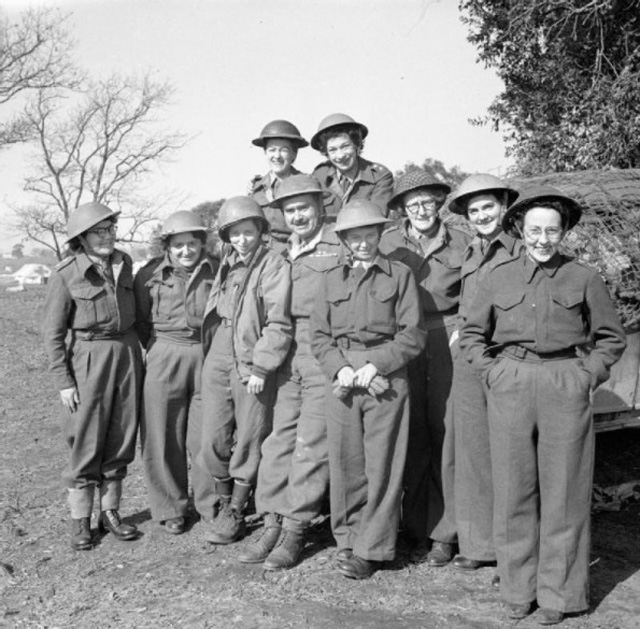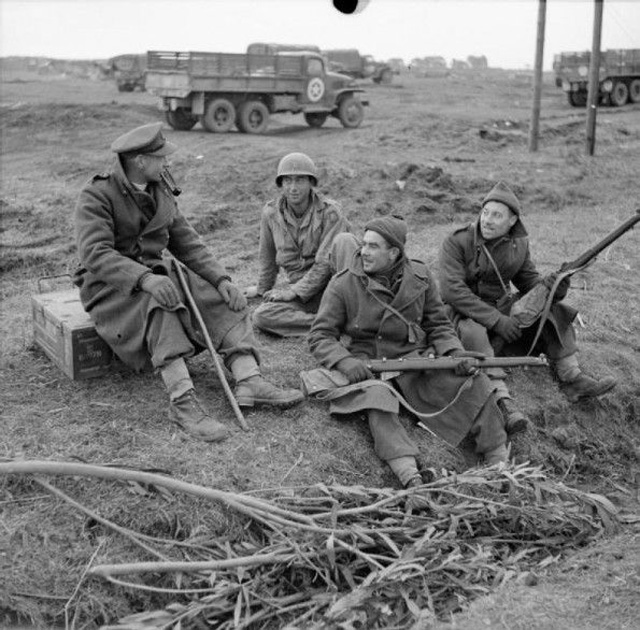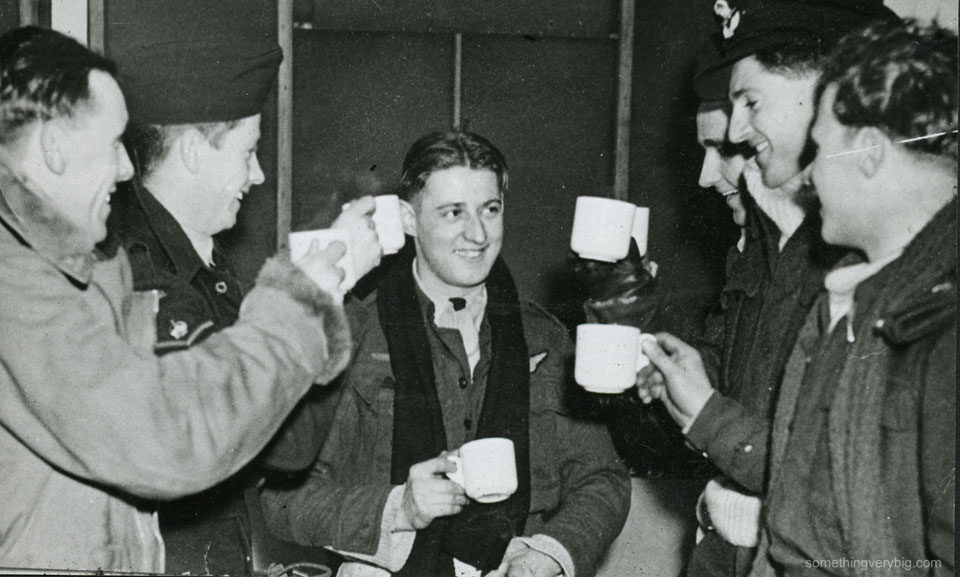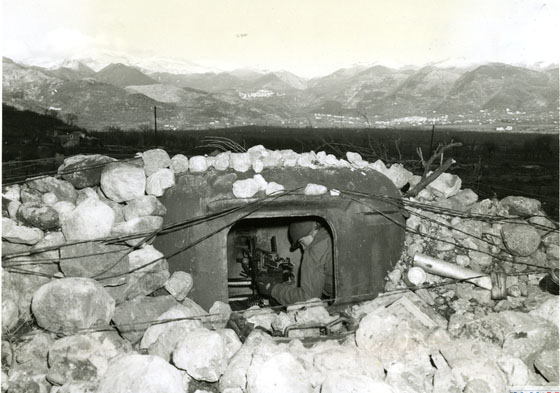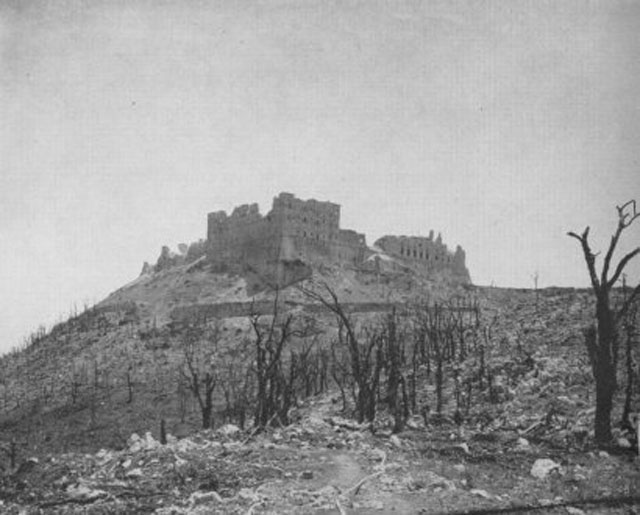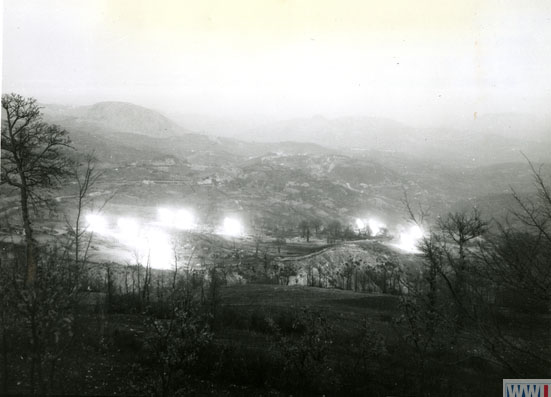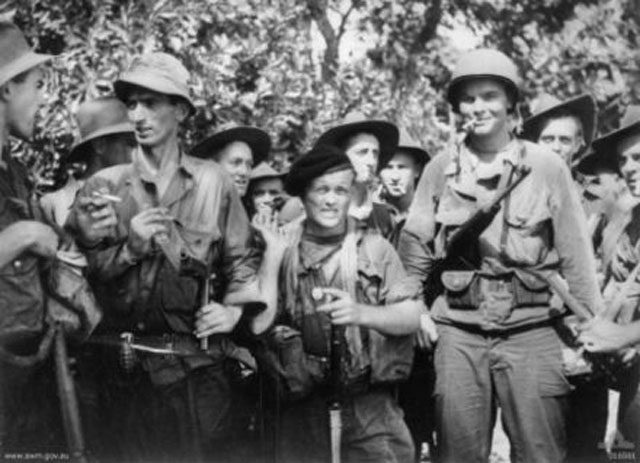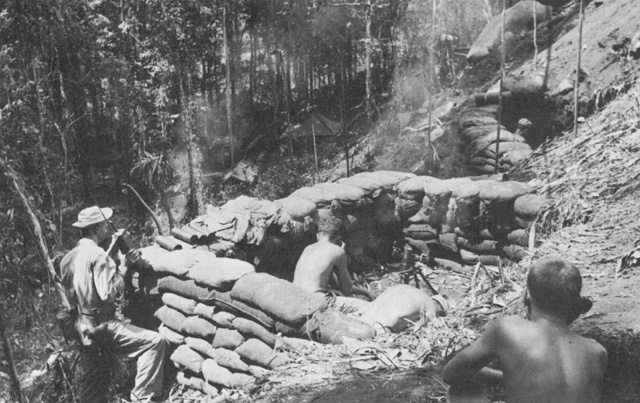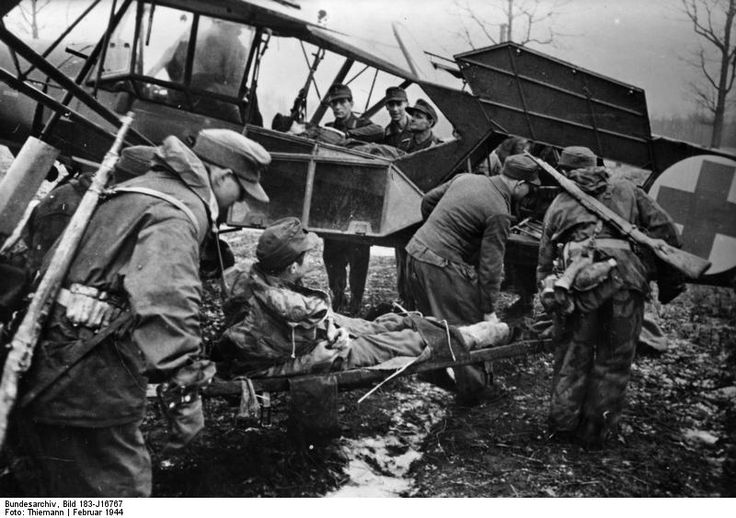Air Operations, Bismarcks
- 23 42nd Medium Bomb Group B-25s attack the Vunakanau airfield at Rabaul.
- VMF-212 and VMF-222 F4Us, and 347th Fighter Group P-38s down 9 A6M Zeros over the Vunakanau airfield between 0930 ad 0950 hours. A V Fighter Command P-38 downs a Ki-61 'Tony' fighter near Cape Hoskins at 1055 hours.
- 20 XIII Bomber Command B-24s attack the Borpop airfield on New Ireland. More than 70 V Bomber Command B-25s and A-20s, and 61 V Fighter Command P-38 escorts attack the Panapai airfield on New Ireland, a seaplane base, and shipping and the port and town areas at Kavieng. 17 V Bomber Command B-24s that encounter bad weather on their way to Kavieng attack Talasea instead. 8 aircraft are downed by antiaircraft fire over Kavieng, but 15 crewmen are rescued by a Patrol Wing 17 PBY out of Cape Gloucester as 2 345th Medium Bomb Group B-25s strafe nearby gun positions.
Air Operations, CBI
BURMA- 10th Air Force fighters and fighter-bombers attack numerous targets throughout Burma. In a novel experiment, P-40s drop land mines in the Nampaung area.
- 4 341st Medium Bomb Group B-25s attack coastal targets on the Gulf of Tonkin, a ship in Haiphong harbor, rail facilities, and bridges.
Air Operations, Carolines
42 VII Bomber Command B-24s attack Ponape Island.
[Air Operations, Europe
The abbey atop Monte Cassino is heavily bombed by Allied air and artillery. Roosevelt says such monuments can not be spared when American lives are at stake. Destruction of the heavily fortified abbey, it was assumed, will deny German defenders their commanding position over the countryside. Even though the abbey is virtually leveled, the Allies still cannot take it. (see Italy below.)
RAF BOMBER COMMANDBattle of Berlin
Evening Ops:
- After a rest of more than 2 weeks for the regular bomber squadrons, 891 aircraft are sent to Berlin. In this total are 561 Lancasters, 314 Halifaxes and 16 Mosquitos. 75 planes abort.
- The main raid takes off in the early evening. The German controllers are able to plot the bomber stream soon after it leaves the English coast, but the swing north over Denmark for the approach run proves too distant for many of the German fighters. The contact with German night figters occurs near the east coast of Denmark. Combats with the fighters continue from there to the outskirts of Berlin. At least 20 bombers are shot down during this period. Flak is given priority over the target area as the German controllers order the fighters not to fly over Berlin. 3 planes are brought down by Flak out of the 775 that make it to Berlin. The time over the target is 21:13 to 21:35. 2,643 tons of bombs are dropped including 1,230 tons of high explosives and 1,413 tons of incendiaries. The heaviest hit areas are west and south of the city center. 320 people are killed and 260 are missing. Included in the bomb loads this raid are 470 4,000 pounders and 15 8,000 pounders. 47 communities in all directions from Berlin report being hit. 61 people are killed outside of Berlin. The diversionary raid on Frankfurt-on-Oder is basically ignored by the night fighters. Some night fighter are detained in the Dutch coast area. As a result 10-15 more bombers are lost on the return part of the flight. Upon returning to England 3 bombers crash and 2 are abandoned being low on fuel.
- 26 Lancasters and 17 Halifaxes are lost. Aircrew casualties include 265 killed, 54 POWs and 5 evaders.
- 23 Oboe Mosquitos attack 5 night-fighters airfields in Holland, 43 Stirlings and 4 Pathfinder Halifaxes lay mines in Kiel Bay, 24 Lancasters of No. 8 Group make a diversionary raid to Frankfurt-on-Oder, 9 aircraft make RCM flights, and 14 Mosquitos carry out Serrate patrols.
- 1 Serrate Mosquito is lost.
- Also, 2 Mosquitos are sent to Aachen, 6 Stirlings and 6 Wellingtons lay mines off Bayonne and Lorient, and 48 aircraft are involved in Resistance operations.
- 1 Stirling is lost on a Resistance flight.
Crews of No 12 Squadron Pose |
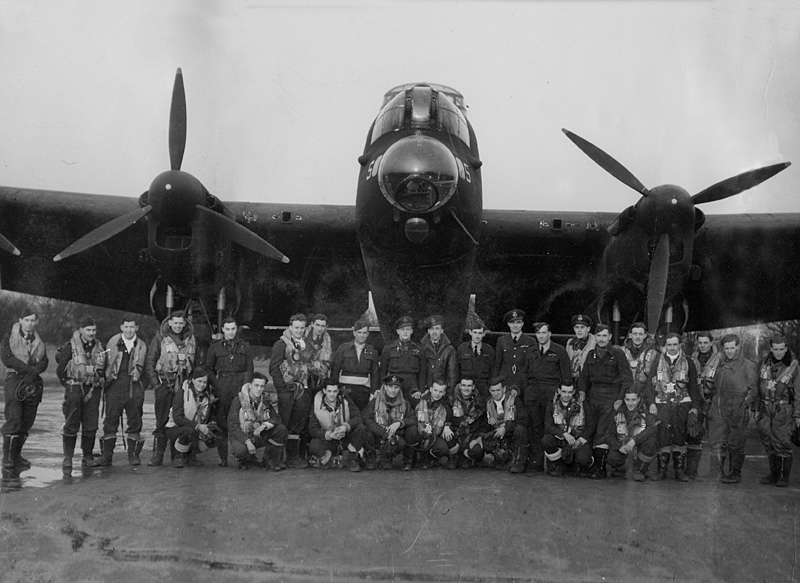 |
BELGIUM:
- 42 VIII Fighter Command P-47 dive-bombers unable to locate their primary target in France bomb an airdrome thought to be in Belgium, either at Nieuport or Coxyde.
- 52 2nd Bomb Division B-24s of the 93rd, 389th, 445th, and 453rd Heavy Bomb Groups attack V-weapons sites in the Pas-de-Calais area with 150 tons of bombs. Escort is provided by 95 P-47s of the 4th and 356th Fighter Groups.
FRANCE:
- During the morning, 247 IX Bomber Command B-26s attack the Cherbourg/Maupertus Airdrome, several V-weapons sites, and several targets of opportunity.
- During the afternoon, 141 IX Bomber Command B-26s attack V-weapons construction sites along the Channel coast.
ITALY:
- XII Bomber Command B-26s attack a rail line and a marshalling yard.
- XII Air Support Command A-20s attack road targets.
- XII Air Support Command fighters and fighter-bombers attack numerous tactiacal and transportation targets in and around Rome and the battle area.
- 52nd Fighter Group Spitfire pilots down 4 Luftwaffe fighters and damage several other aircraft near Viterbo Airdrome, in central Italy, about 1635 hours.
ITALY:
- 15th Air Force B-17s mount the first heavy-bomber attack on German Army fortifications on Monte Cassino, where the entire Allied ground effort has come to a halt in the face of unprecedented German resistance enhanced by a seemingly unbreachable defensive position. The 142 B-17s assigned to the mission drop 353 tons of bombs on the monastery, which, along with XII Bomber Command B-25s and B-26s, reduce the irreplaceable historical treasure to rubble. Still, the German Army resistance to follow-on ground attacks appears unfazed.
- More that 60 15th Air Force B-24s attack marshalling yards at two locations.
Air Operations, Marshalls
VII Bomber Command B-24s and 10 15th Fighter Group P-40 fighter-bomber attack the Mille Atoll.
[Air Operations, New Guinea
49th Fighter Group P-40s down 9 Japanese fighters over Wewak between 1030 and 1050 hours.
[Air Operations, Solomons
- A VMF(N)-531 PV crew downs an E13A 'Jake' reconnaissance float plane near the Green Islands at 0505 hours.
- Under an umbrella provided by 32 fighters from 8 US Marine Corps F4U squadrons, New Zealand Army ground troops land without opposition at Nissan Island, the largest of the Green Island group. At 0641 hours, an estimated 15 D3A 'Val' dive bombers attempting to attack the invasion flotilla are driven off by the covering aircraft and antiaircraft fire. Fighter-director teams equipped with radar are functioning ashore by nightfall.
- VMF-212 F4Us down 6 D3A 'Vals' near the Green Islands at 0645 hours.
Argentina
A group of 6 officers including Juan Peron occupies the Foreign Ministry to prevent the declaration of war on the Tripartite Pact countries.
[Diplomatic Relations
The Polish Government in London rejects a Soviet proposal that the Curzon Line, 322 km west of the 1939 Russo-Polish frontier should now be the post-war frontier.
[Eastern Front
In the northern sector units of the Russian 2nd Assault Army and the 42nd and 67th Armies cross the Narva River and capture several Estonian villages.
NORTHERN SECTORHitler agrees to allow Army Group North to abandon the Luga position and fall back to the borders with the Baltic States.
SOUTHERN SECTORIn the Korsun pocket the 72nd Infantry Division captures Chilki, but encounters severs Soviet resistance. As casualties mount the German attacks weaken. Stemmerman knows that if the breakoud does not begin soon his corps will succumb to the relentless Russian attacks. However, with the fall of Chilki, he has established a base for the breakout and impatiently awaits Manstein's order. This is duly given, Stemmerman immediately proceeding to move the bulk of his forces to their attack sectors. Only a thin screen is left to cover his rear. Outside the pocket the III Panzer Corps continues its attacks but is simply unable to break the strengthened outer ring.
[Gilbert Islands
Aircraft of the US Navy, taking off from Abemama Island, bombard the Japanese base at Wake.
[Italy
The monastery on the crest of Monte Cassino is heavily bombed at the request of the New Zealand Corps. 147(135?) B-17 Flying Fortresses in a first wave and 82 B-25s in a second wave drop some 493 tons of bombs on Monte Cassino. The abbey, one of the shrines of western Christian culture, is completely destroyed, and the bishop and several of the monks are killed along with 400 Italian women and children refugees. Despite the reports by US troops formerly in the sector that no fire has come from the monastery, more recent reconnaissance has suggested a German presence. The decision to bomb the Benedictine abbey was taken in response to the request made by Gen Bernard Freyberg, commander of the New Zealand Corps, on the 12th. Freyberg and Sir Francis Tucker of 4th Indian Div, who have the responsibility of ordering their men to attack the position, decide that it must bombed. Freyberg maintained that the historic edifice has been transformed by the Germans into a sort of fortress from which the enemy could overlook every movement made by the Allied forces in the sector, thus frustrating every attack.
Freyberg's conviction received strong support from evidence given by the British Gen Sir Henry Maitland Wilson, who declared that when he flew over the abbey at a low altitude he saw German soldiers in the courtyard. Freyberg's responsibility is heightened by his awareness that he leads a large proportion of New Zealand's military manpower. In fact the Germans have been scrupulous not to enter the monastery and have taken the trouble to transport some of its treasures to the safety of the Vatican. Marshal Kesselring had formally assured the Vatican that the abbey would not be occupied and that none of his soldiers would set foot in it. To make certain of that a kind of 'free zone' was established for a radius of 300 meters around the abbey and all soldiers were forbidden to enter it.
Freyberg's request aroused fierce argument in the Allied camp. Many were firmly against bombing the monastery and the air force commander, Ryder(?), for instance, queried Wilson's evidence. Gen Keyes, Commander of the US II Corps, who was actually responsible for operations in the Monte Cassino sector, stated categorically that none of his soldiers had ever seen a single shot fired from the abbey. At this point in the argument Gen Mark Clark, Commander-in-Chief of the US 5th Army, of which Freyberg's Corps forms part, who was expected to give the final decision, passed the buck to his direct superior, the Commander-in-Chief of the XV Army Group, Gen Alexander, and he, relying on Gen Wilson's evidence, ordered the bombardment to go ahead.
Once the abbey has been bombed, however, the German 3rd Parachute Regt under Col Sebastian Heilman, a unit of picked men belonging to Gen Richard Heidrich's 1st Parachute Div, move in and find that the ruins and cellars provide an excellent position
better that the undamaged buildings would have been. They site their own guns there now really turning the ruins of Monte Cassino into a kind of fortress. From it the Germans can now observe unseen the slightest movement on the part of the enemy. Moreover the Allies have not co-ordinated the bombing of the abbey and operations by other formations, so that, for example, Gen Tucker, Commander of the 4th Indian Div, does not know the exact time fixed for the bombardment and his own troops go into action too soon and achieve little or nothing. What is more he directs his attack not at Monte Cassino but at Monte Cavario, three-quarters of a mile away.
In the US 5th Army's VI Corps area, the VI Corps is reorganizing and strengthening the beachhead to meet the threat of an enemy counteroffensive. The 36th Engineers now hold part of the Moletta River line, replacing most of the 157th Infantry. During the night, the British 56th Division, which is in the process of moving to the VI Corps zone from the British X Corps sector, takes over the left flank from the positions of the 36th Engineers almost to the Albano road. The the east, the 45th Division holds the front line. The British 1st Division is withdrawn for rest and refitting.
[Marshall Islands
The invasion force for Eniwetok sails from Kwajalein.
[Mediterranean
The US freighter Elihu Yale (7176t) is hit by a bomb the explosion of which starts fires that spread to tank landing craft LCT-35 alongside, destroying that vessel as well. The fires are eventually brought under control, but Elihu Yale is later written off as a total loss. 2 of the 40-man Armed Guard and 3 of the 45-man crew die in the attack.
[Occupied France
Martial law is declared in 7 French coastal departments along the Mediterranean coast. Expecting an Allied invasion, the Germans take direct control of the area.
[Pacific
- A Japanese convoy is smashed by US bombers off New Hanover near Rabaul.
- The Japanese submarine I-43 is sunk by the US submarine Aspro (SS-309) in the Central Pacific area.
- The Japanese submarine RO-40 is sunk by the US destoyer Phelps (DD-360) and the minesweeper Sage (AM-111) in the Marshall Islands area.
- The US submarine Gato (SS-212) sinks the Japanese guardboat No. 3 Taiyo Maru off Rabaul, New Britain.
- The US submarine Snook (SS-280) sinks the Japanese merchant cargo ship (No. 2 Hoshi Maru) (875t) off the south coast of Korea.
- The US submarine Tinosa (SS-283) attacks a Japanese convoy east of Mindanao, P. I., and sinks the army cargo ship Odatsuki Maru (1988t) east of Dinagat Island.
- The British submarine Tally Ho sinks the German-manned Italian cargo submarine UIT-23 southeast of Penang, Malaya.
Solomons
Part of Gen Harold E. Barrowclough's New Zealand 3rd Division is landed by Adm Theodore S. Wilkinson's III Amphibious Force on the Green Islands, north of Bougainville. Adm Aaron S. Merrill's TF 39 provides the escort. All the Japanese defenders have been overcome by February 21. Capture of the island provides the Allies with an air base on 117 miles from Rabaul.
[Images from February 15, 1944
|
|
|
|
|
|
|
|
|
|
